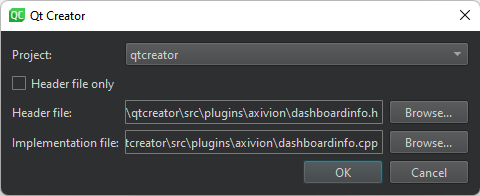Apply quick fixes
To apply quick fixes while refactoring code, select them in a context menu in the code editor. The fixes available depend on the position of the cursor in the code editor.
- To apply quick fixes to QML code, right-click an item ID or name.
- In the context menu, go to Refactoring and then select a quick fix.
Or, select Alt+Enter to open a context menu that has quick fixes available in the current cursor position.
By default, the refactored files are saved automatically. To turn off this feature, go to Preferences > Environment > System and clear Auto-save files after refactoring.
Move classes to separate files
Apply the Move Class to a Dedicated Set of Source Files quick fix to move a class to a separate set of header and implementation files.

Specify paths and file names for the header and implementation file.
To omit the implementation file, select Header file only.
See also Rename symbols and QML Quick Fixes.
Available under certain Qt licenses.
Find out more.

